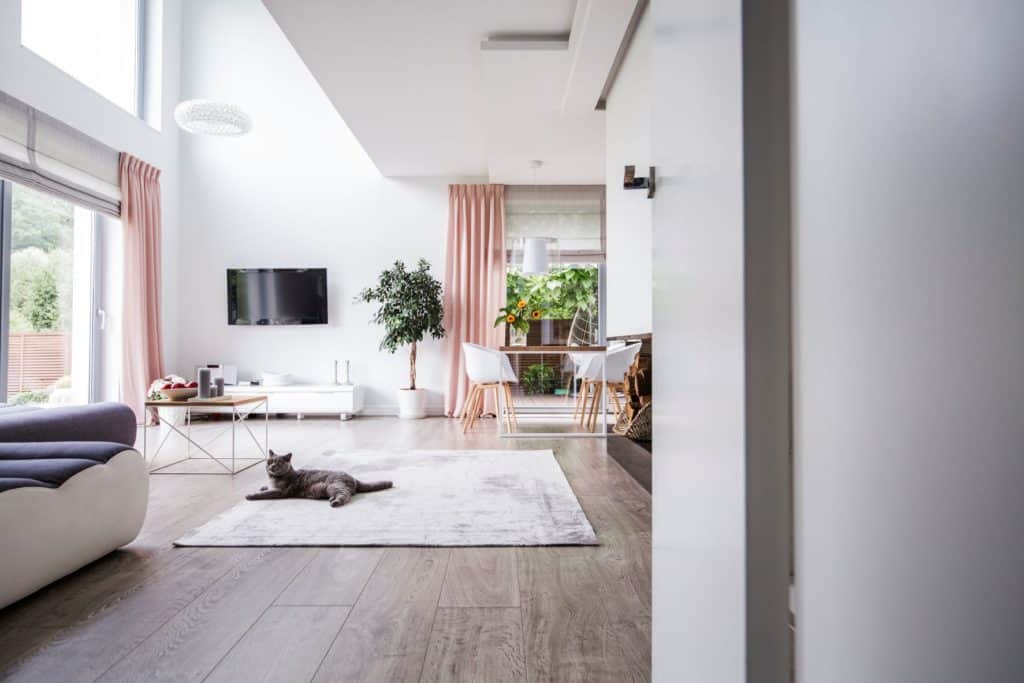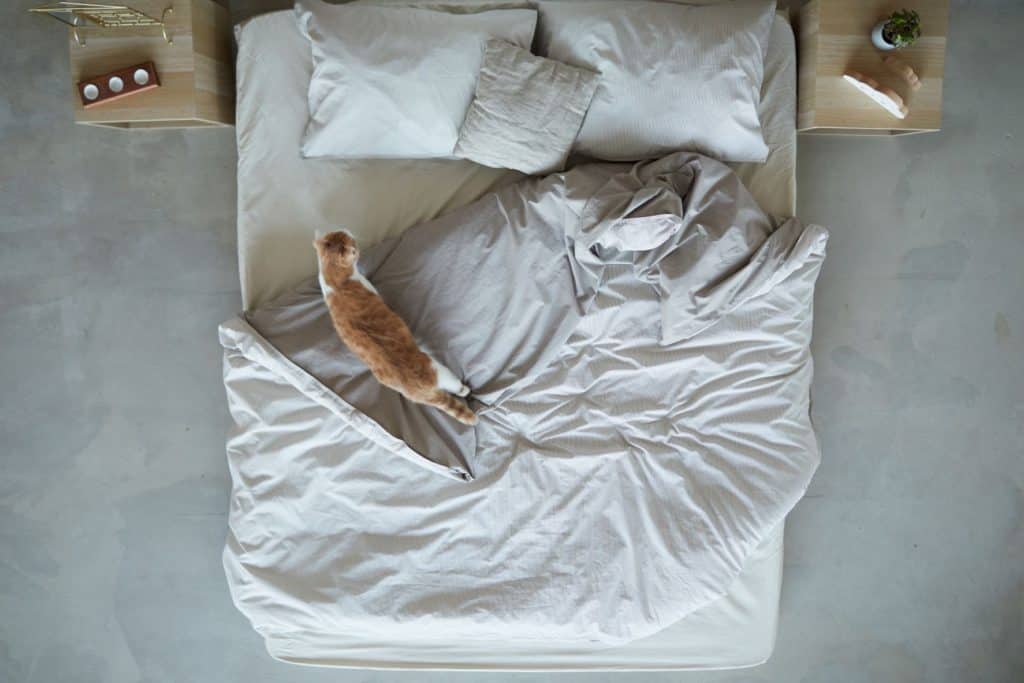How big exactly does an apartment have to be to have a cat as a pet? According to the ASPCA (The American Society for the Prevention of Cruelty to Animals), The minimum recommended space for a cat to live in would be about 18 square meters (or 194 square feet). Visually, this is about 1.2 times as big as the average standard American/Canadian parking space. Therefore, 18 square meters is also the minimum recommended apartment size. Studio or small apartments are around that size or larger.

The ASPCA recommended space requirements are more of a guideline, but it gives cat butlers a good idea of the size required that a cat needs. Along with these guidelines and my own real experiences with fostering/living with cats in a tiny apartment, this article will focus on the needs in terms of space and other requirements that a cat will need inside a small apartment.
I get this question a lot as people are surprised to know that I have four cats in my tiny apartment. I have lived in a small one-room apartment (about 20 square meters) with my four cats (A Bengal cat, a Russian Blue cat, a Scottish-Straight cat, and a Domestic Shorthair) and am now in a slightly larger apartment (approximately 30 square meters) with two rooms.
Does Apartment Size Matter? Isn’t a Larger Apartment Better For Cats?
For dogs, having a larger space is indeed more beneficial, but cats, as we know, are entirely different behaviorally from dogs. Many cat owners are generally worried about how much space they can provide, but instead, it’s better to worry about how our cats will use the area.
A small, well-thought-out cat-centric apartment will always be better than a large apartment with no thought about how the cats will use the space. Additionally, we have to be aware that cats are both prey and predator. A large open space or apartment can make cats feel exposed and vulnerable.

Therefore, cats enjoy a variety of small, enclosed spaces for their sense of security (and warmth). They also want tall vertical areas for navigation and perching. As a result, creating a cat-centric space for a large open apartment might be more complicated than doing it in a smaller apartment.
Minimum Apartment Size for Cats: Useful Chart
This chart is a combination of what is recommended by the ASPCA, my experience with living with cats, and helping others to live with their cats in small spaces and apartments.
A quick thing to mention is that the more cats you have, the more playtime, attention, and environmental simulation that you should provide for your cats to compensate for the lack of space.
| Maximum # of Cats | Minimum Apartment Size | Comments |
|---|---|---|
| 1-2 | Approximately 18 square meters | One cat generally won’t be too fussed about the size, nor will they care much about elevated spaces because they’re the sole owner of the area. Two cats will require some catification to provide more enrichment and ways they can navigate the space. |
| 2-3 | Approximately 30 square meters | When multiple cats live in a small space – we have to think about our small space as a room with many zones. To provide more zones is to provide more vertical places to get to. Remember, cats are territorial, and if they have more territory (it doesn’t matter if it’s horizontal or vertical), the more confident they are. As a result, the higher chance for healthy relationships between cats and humans. |
| 3-4 | Approximately 40 square meters | Three or more cats in a small space need a lot more thought and creativity of how to use the available space. Additionally, extensive knowledge of cat behaviors and socialization might be required. |
What If My Apartment Is Smaller Than The Recommended Size?
So that begs the question, is it possible to bring all of those things inside a small apartment? Of course, but there are limits. You should not adopt a cat in your apartment if:
- Your apartment is too small if you cannot provide a cat’s mental and instinctual requirements along with their physical then it might be best to not have a cat companion at this moment.
- Your apartment or living arrangement is smaller than 18 square meters.
- So cluttered that you might risk stepping on your cat or your cat getting into something they shouldn’t then it’s too hazardous to have cats around.

While there are exceptions based upon the cat’s personality, it’s best to meet those requirements for the proper development of your cat.
Maximum Amount of Cats in an Apartment
The more cats you have, the more resources and space you have to provide. In any space, home, or apartment, you should never exceed 10 to 12 cats!
If you’re interested in adopting or fostering more cats in your apartment, here’s what you need to know:
- A great way of allowing the cats to have their own space is by catifying your apartment.
- The litter box will be filled quicker (especially if it’s a small litter box) and will require scooping and cleaning the litter box more often. For example, with four cats in my apartment, I scoop my litter box every morning! Here’s the litter and litter box that I recommend, plus tips on how to deal with litter tracking!
- but if you can provide more vertical space and have the things necessary for the cats to feel confident then it’s easy to add more cats.
- In my experience with my 4 cats, more cats mean more attention and play therapy! It not only helps them expend their energy but prevents a lot of behavioral issues that cats might develop such as biting or scratching!
Keeping Your Cats Happy in Any Apartment Size
If you visit a dog person’s home, you will probably immediately notice the dog. However, if you see a cat person’s home, it might be difficult even to tell if there is a cat.
Life In An Apartment Vs Life Outside
An outdoor cat is so much more stimulated than an indoor cat. That’s the truth of it. There’s always something to chase and climb. However, the outside world has its risks and dangers. On average, an outdoor cat only lives about three years, much less than an indoor cat’s lifespan at around 17 years.

However, it doesn’t mean that those 17 years of life will be stimulating. I have seen too many cats living such a sedentary life that they become fat and sick. We want them to live a long life, but at the same time, we also want them to be happy and stimulated.
As such, it’s important to take notice of what a cat needs physically and instinctually. All cats are propelled by their nature so it’s up to the butlers to bring as much as we can from the outside to inside our apartments in a safe and enjoyable way. It doesn’t matter if it’s a small apartment or a large one.
What Are A Cat’s Physical Requirements In An Apartment?
While obvious, this is the requirement for any pet. They need to be fed and have someplace to relieve themselves. However, this is too basic, and many people think that this is enough, even people who live in very large homes.
- Food/Water – Everything needs to eat and drink so this is a no brainer. I feed my cats grain-free dry food and feed them wet food when I can. I always feed them on a set schedule, no free feeding.
- Safety – The reason we want to keep our cats indoors is to provide them with a safer life than living outdoors. A room free of clutter and keeping them away from harmful chemicals and substances.
- A Place To Relieve Themselves (Litter Box) – Again, every living thing needs a place for them to relieve themselves and cats are no different. The number of litter boxes in an apartment will vary from place to place, however, in a studio apartment, I believe one litter box will be sufficient for most cat homes (1-3 cats).
What Are A Cat’s Instinctual Requirements In An Apartment?
Again, it doesn’t matter if you live in a tiny studio apartment or a huge mansion. These are the two important requirements that a cat needs to have a stimulating life!
Cats Need to Have Confidence in Their Environment (Territorial Confidence)
- Cats are territorial creatures, they want to climb high places, scratch to leave their scent, and a little bit of privacy from things that might invade their personal space.
- If you can understand that cats are both predator and prey then you can probably understand why they feel safer when they’re at high vantage points. They need to spot what they can hunt or what might hurt them.
- Cats are most comforted with the scent of themselves. Giving them a lot of places for them to scratch and deposit their scent, gives cats a greater sense of security in their environment.
- Vertical spaces give them the confidence that they need in their environment. This is easy to achieve through the use of cat poles, hammocks, or even regular racks. They love to play, climb, and rest in these places and there are many designs that will satisfy both you and your cat.
These places also provide a lot of privacy a cat might want just in case it becomes a little too loud or rowdy in the apartment. Here are some of the best cat furniture and products that I recommend in small apartments!
Cats Need To Play and Hunt
- Cats are hunters and that’s what they were made to do. To satisfy their need to hunt and catch things through play is one of the most important things in their development and lives in general.
- The thing a cat misses most from the outside is the sense of being the hunter. Outside they can chase small creatures and insects, so what you can do that simulate that in an apartment? Interactive toys! Whether it’s a laser, wand feather toy, or a ball that they can play fetch with (my Bengal loves to fetch!) – playing is not optional! It’s a mandatory part of owning a cat and people often neglect it and in a studio apartment, this is crucial.
- Your playtime determines your cat’s energy rhythm. If you play with them every night before you go to bed, they recognize when it’s time to calm down and allows you to have a good night’s sleep (if you aren’t having a good night’s sleep, this article might help). Those stories of cats going crazy in the middle of the night are lacking scheduled playtimes.
- Having a companion cat helps too! They expend their energy on each other and practice their hunting and chase each other around. Cats are not solitary animals even though they might be uncomfortable for a little bit. Follow my easy introduction steps! They enjoy the company and help each other’s development.
- Situational toys such as tunnels that they can explore and hide in are also great! These are toys that can put out when you’re out of the house or working and then be put away easily when you need the extra space. I really love these types of toys because it allows a different type of environment for the cats to play in.
Conclusion
My life with my cats is so valuable to me that I hope to share this with the people thinking about getting a cat or multiple cats indoors. Whether you live in a huge mansion or a small apartment, all it takes is a little observation of what they need and a little creativity!
